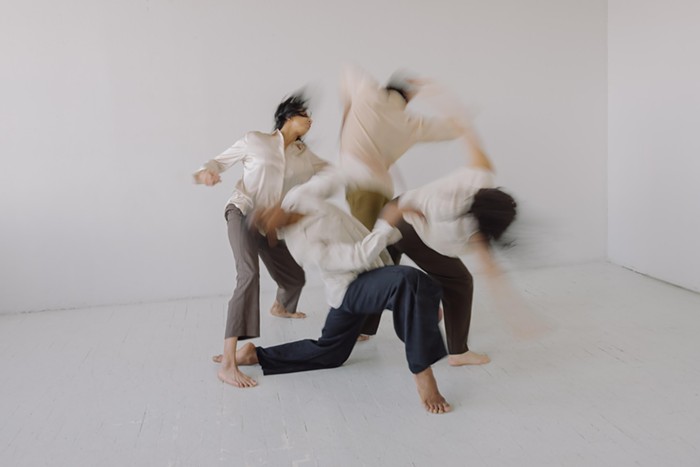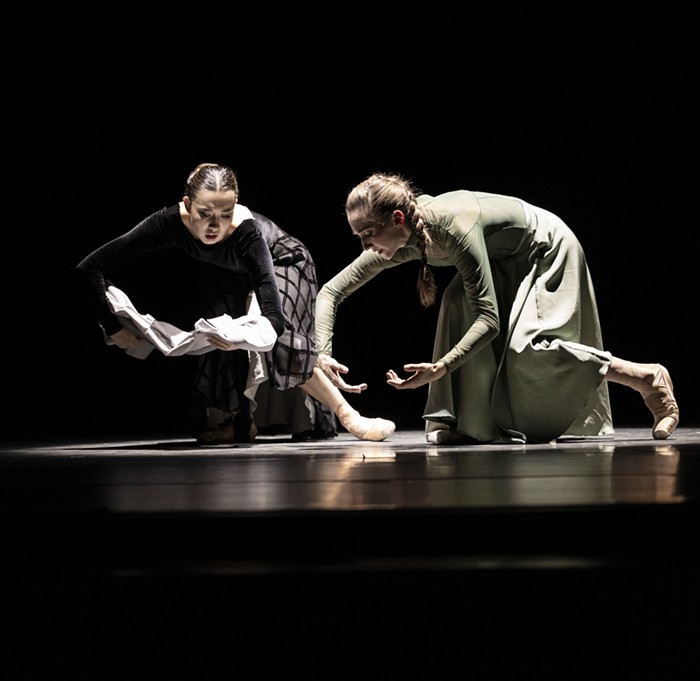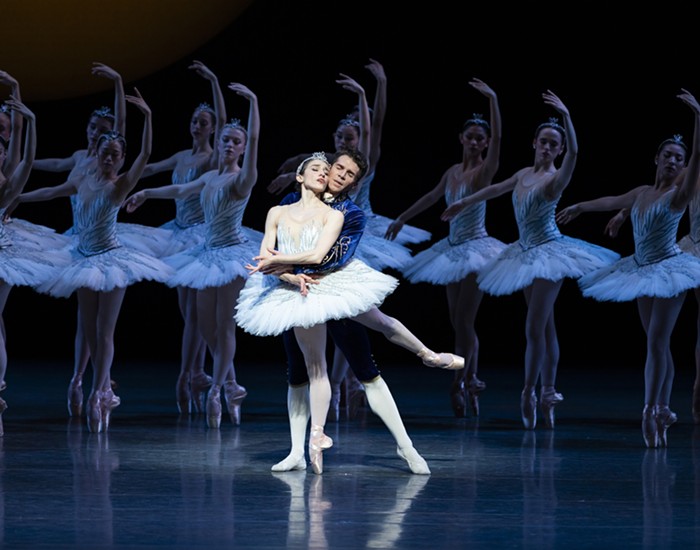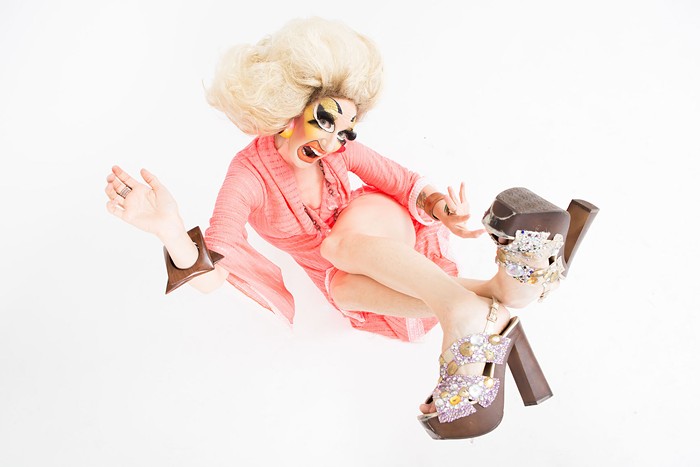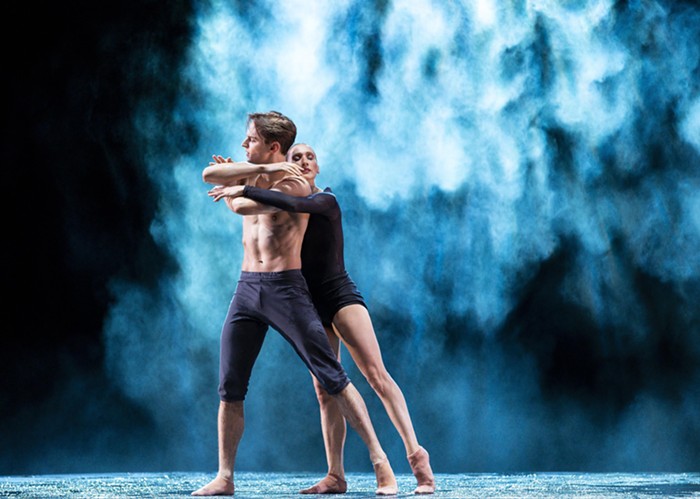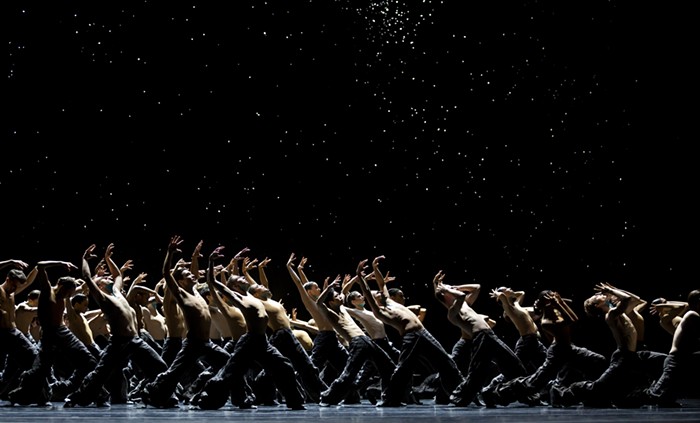
The region's premier ballet haus has quite the weekend planned. Last but foremost, on Sunday, longtime principal dancer Carie Imler bows out with an encore performance of her Black Swan from Swan Lake. She's the best in the business in that role, so says my esteemed colleague Megan Burbank in her fantastic profile of the badass ballerina.
^^^INSANE^^^
If you don't want to pay $40 for the nosebleeds at that performance, you'd do just as well to shell out $50 for the good seats to see Pictures at an Exhibition, which runs tonight and tomorrow. The show I saw last night felt like taking a summertime walk through the city, if the city was a Kandinsky painting. Which is good. Because that was kind of the point.
Anyhow, the evening starts off with La Source, a bright, springy little classical number by Léo Delibes. Principals Imler and Jerome Tisserand were a little off in the romantic pas de deux that initiates the live, pink math Balanchine makes of this music, but they cleared that shit right up by the third movement during a bit of choreography that has Tisserand supporting Imler in her slow-mo turns as if he were winding a human-sized watch for like a minute-and-a-half. Burbank wasn't lying when she described Imler as a "visibly strong" athlete of the highest order; the last half of her performance here is living proof.

Major props to Elizabeth Murphy, too, who commanded her corps with precision as they transformed their bodies into Delibes's spritely flutes.
Dressed in a very white leotard, the very young-looking and very blonde-looking Dylan Wald stood centerstage looking like a lightning bolt in the middle of storm-colored dancers for Sergei Prokofiev's moody Opus 19/The Dreamer, choreographed by Jerome Robbins.

A ferocious and graceful particle in the form of Sarah Ricard Orza breaks from the cloud and tries to connect with our brooding hero, but she keeps getting drawn back to her tempestuous friends. There's a moment of exquisite, lyrical anguish in the last two minutes of the last movement where those friends form a sort of slow-motion night breeze. As a plaintive violin weeps alone in the pit, Ward twists and shivers and releases the anxiety he's been trying to contain throughout the performance, and it's just gorgeous and painful and sad. At the end, he and Orza literally—and I'm not using that word lightly—come together to form a balletic version of the shrug emoji in order to convey love's ambivalence.
¯\_(ツ)_/¯ ¯\_(ツ)_/¯
The emotional and aesthetic distances between the Balanchine and the Robbins is great—restraint yields to controlled wildness, ebullience to long stretches of turbulence—but those distances are worth traversing, especially when Stranger Genius nominee Noelani Pantastico and James Moore (of Romeo et Juliette fame) dance the piece on Saturday. (That's no shade on Wald. Wald did great.)
Just when you've begun to drown in Robbins's deep blue pool of melancholy, and right as you begin to think his piece was some giant metaphor for the thousand personal pains of bisexuality or closeted homosexuality, two big handfuls of dancers in abstractly expressive, pastel-colored costumes take the stage for contemporary choreographer Alexei Ratmansky's take on Modest Mussorgsky's Pictures at an Exhibition. Kandinsky's Color Study: Squares with Concentric Circles is projected in the background, and all is right with the world again.

The story behind the music is that Mussorgsky composed Pictures in honor of the painter Viktor Hartmann, who died younger than he should have. The 16-movement piece is supposed to mimic the sensation of walking from painting to painting in a gallery. Instead of using Hartmann's "spooky" paintings, Ratmansky and projection designer Wendall K. Harrington use lightly animated pictures from Kandinsky's colorful contributions to the world of abstraction.
Throughout, pianist Allan Dameron plays the hell out of that Mussorgsky. Before hearing this version of Pictures, I'd thought that Ravel's brassy, colorful orchestration of the piece was unimpeachable. But I ended up preferring this more spacious, original version for solo piano.
Almost all of the ballet is expertly executed playful silliness choreographed to make you giggle, but there's a pas de deux between Miles Pertl and Lindsi Dec about 1/3 of the way through that will make you believe that God formed human beings from clay, and in His image. At the end of it, Pertl lifts Dec in a way that I've never seen anyone lift anyone else before. It's a demonstration of beauty and strength and endurance that would stun the most insufferably impressive couple's yoga partners in the park.
In general, the ballet felt like a showcase for many of PNB's young dancers, and besides Pertl and Dec, Angelica Generosa stood out among the corps for her incredible speed and technical skill.
Like the music, the dance's loose narrative is present but hard to follow. What you feel instead are the splendid and sometimes tragic moments of beauty and color that the world presents to you on a long walk through a fascinating, new city.

